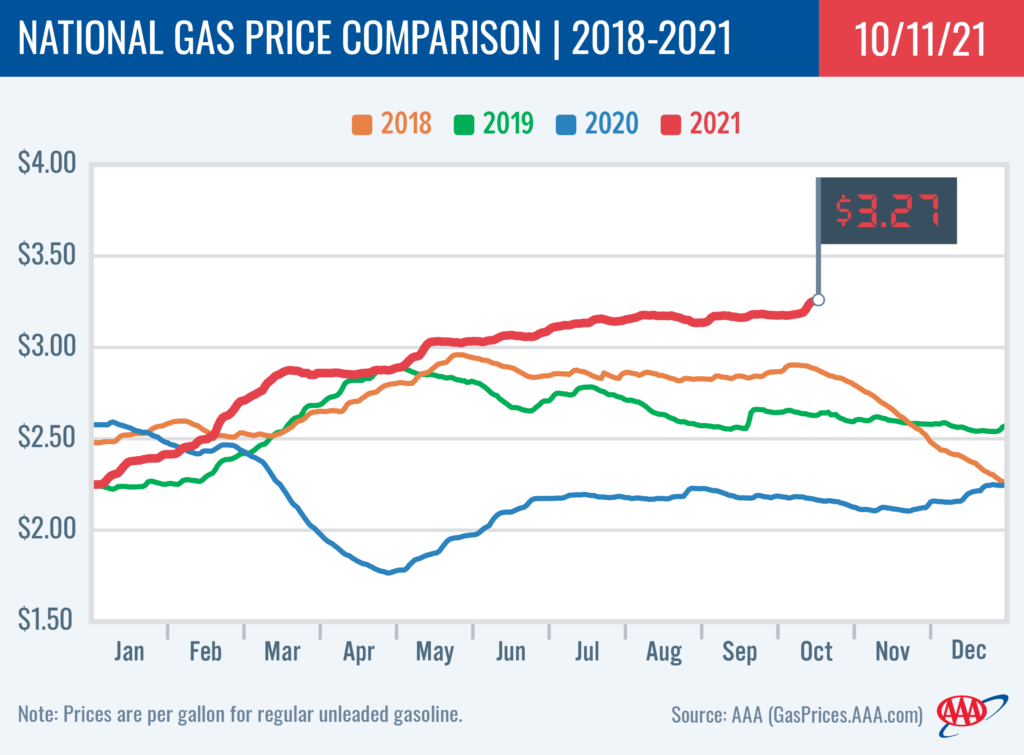WASHINGTON, D.C. — The national average price for a gallon of gas rose 8 cents on the week to reach $3.27. This is the highest price since October 2014 and is primarily due to the surging price of crude oil, which crept above $80 bbl before edging slightly lower.
“The key driver for this recent rise in the price of gas is crude oil, which typically accounts for between 50% and 60% of the price at the pump,” said AAA Spokesperson Andrew Gross. “And last week’s decision by OPEC and its oil-producing allies to not increase production further only exacerbated the upward momentum for crude oil prices.”
Crude prices rose quickly following OPEC+, which comprises the Organization of the Petroleum Exporting Countries (OPEC), Russia, and their allies, choosing not to move forward with an agreement to produce 800,000 b/d in November. Instead, OPEC+ decided to maintain a previously agreed upon 400,000 b/d production increase.
According to new EIA data, total domestic gasoline stocks increased by 3.3 million bbl to 225.1 million bbl last week. Gasoline demand also increased slightly from 9.40 million b/d to 9.44 million b/d—the slight increase in gas demand aided in the national average’s rise. However, the main culprit for rising pump prices remains high crude prices above $74 per barrel.
Meanwhile, a breach and spill in a key pipeline supplying fuel to parts of the southeastern U.S. led to tightened regional supplies. Kinder Morgan Inc. (KMI) said it expected repairs to its southeastern products pipeline to be completed October 9, with a restart afterward. The repairs were slowed by the recent heavy rain and flooding around Birmingham, Alabama. The spill took place on October 1. The pipeline serves various metropolitan areas, including Birmingham, Alabama; Atlanta, Georgia; Charlotte, North Carolina; and Washington, D.C.
Today’s national average of $3.27 is 10 cents more than a month ago, $1.09 more than a year ago, and 63 cents more than pre-pandemic in 2019.

Quick Stats
- The nation’s top 10 largest weekly increases: Washington, D.C. (+17 cents), Kentucky (+15 cents), Indiana (+15 cents), Florida (+13 cents), Michigan (+12 cents), Alabama (+12 cents), Tennessee (+12 cents), South Carolina (+11 cents), Illinois (+10 cents), and Delaware (+10 cents).
- The nation’s top 10 most expensive markets: California ($4.44), Hawaii ($4.12), Nevada ($3.87), Washington ($3.85), Oregon ($3.75), Idaho ($3.72), Alaska ($3.71), Utah ($3.70), Colorado ($3.52) and Wyoming ($3.51).
Oil Market Dynamics
At the close of Friday’s formal trading session, WTI increased by $1.05 to settle at $79.35. Alongside the actions of OPEC+ last week, prices increased after the U.S. Department of Energy dispelled speculation that the Biden Administration would ban crude exports or sell crude oil held in the U.S. Strategic Petroleum Reserve. The sale could have put more crude into the domestic market, but it is unlikely to have had a sustained downward impact on oil prices. Prices have increased last week despite EIA’s latest report showing that total domestic crude inventories increased by 2.4 million bbl to 420.9 million bbl last week. For this week, crude prices could continue to climb if supply tightens.
Motorists can find current gas prices along their route with the free AAA Mobile app for iPhone, iPad and Android. The app can also be used to map a route, find discounts, book a hotel and access AAA roadside assistance. Learn more at AAA.com/mobile.
